Unit 6 An old man tried to move the mountains 单元整体教学设计(6课时) 人教版英语八年级下册
文档属性
| 名称 | Unit 6 An old man tried to move the mountains 单元整体教学设计(6课时) 人教版英语八年级下册 |
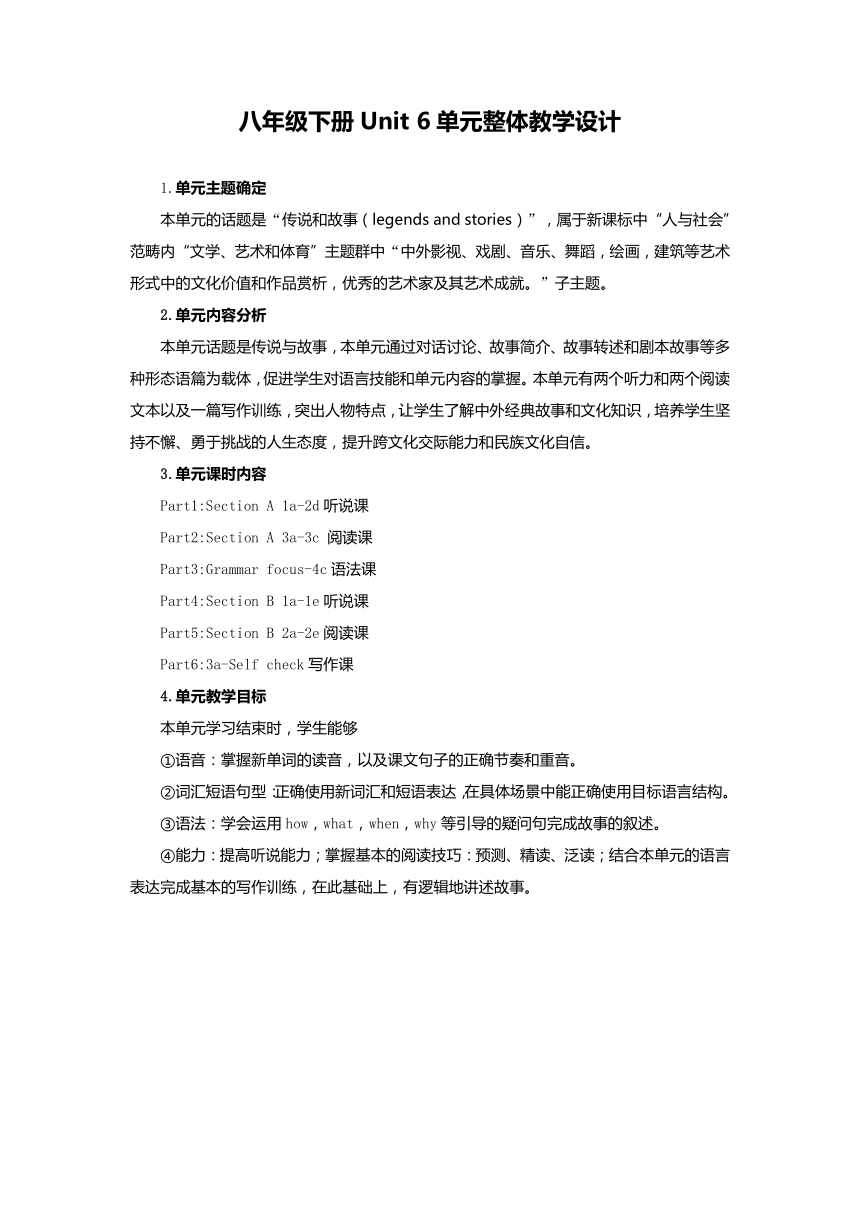
|
|
| 格式 | docx | ||
| 文件大小 | 33.1KB | ||
| 资源类型 | 教案 | ||
| 版本资源 | 人教新目标(Go for it)版 | ||
| 科目 | 英语 | ||
| 更新时间 | 2024-06-03 07:59:18 | ||
图片预览

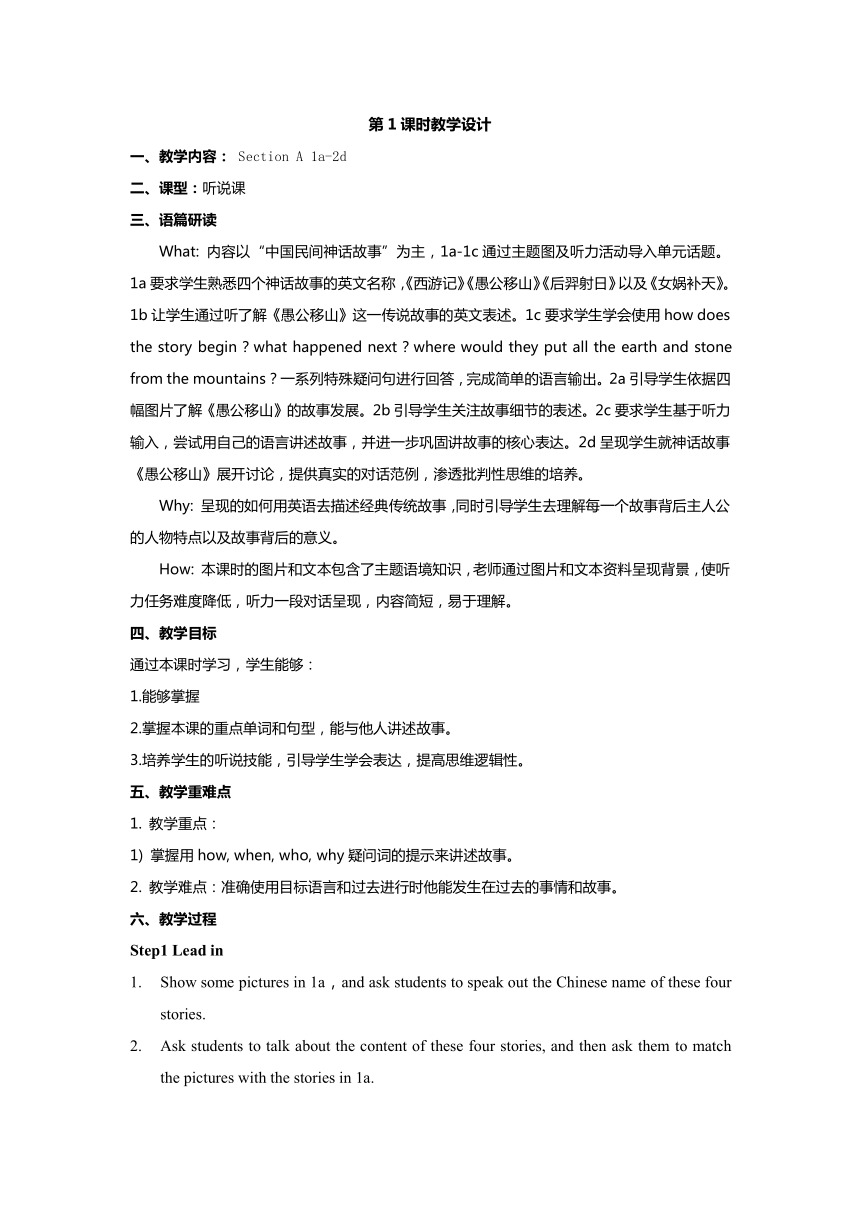
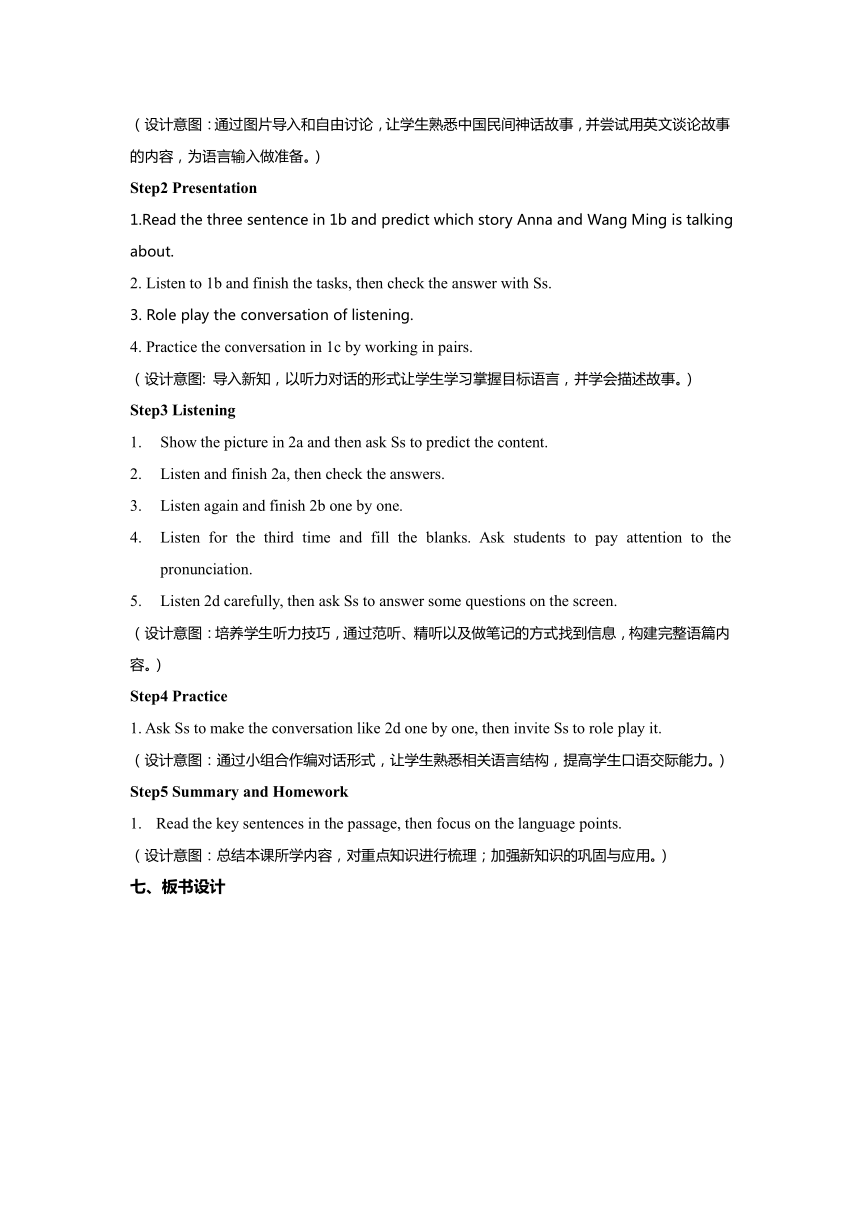
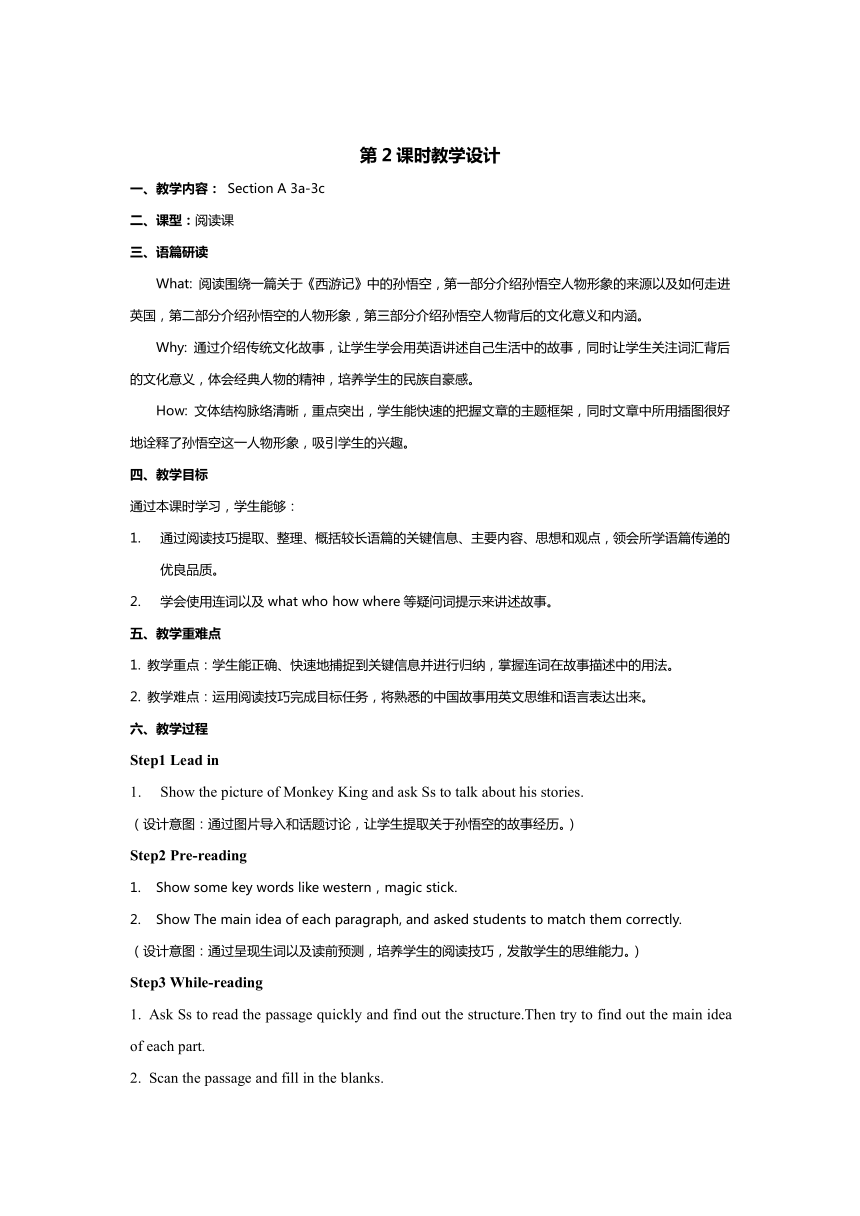
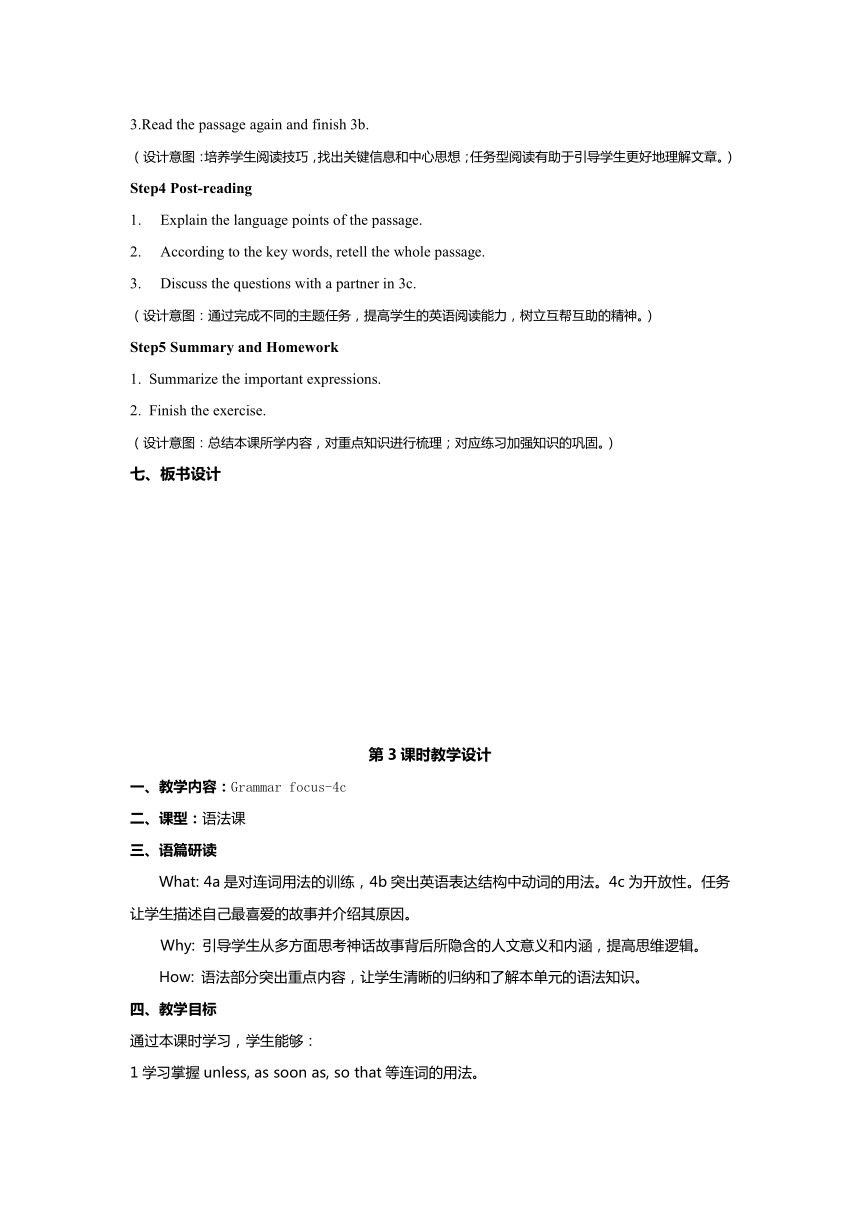
文档简介
八年级下册Unit 6单元整体教学设计
1.单元主题确定
本单元的话题是“传说和故事(legends and stories)”,属于新课标中“人与社会”范畴内“文学、艺术和体育”主题群中“中外影视、戏剧、音乐、舞蹈,绘画,建筑等艺术形式中的文化价值和作品赏析,优秀的艺术家及其艺术成就。”子主题。
2.单元内容分析
本单元话题是传说与故事,本单元通过对话讨论、故事简介、故事转述和剧本故事等多种形态语篇为载体,促进学生对语言技能和单元内容的掌握。本单元有两个听力和两个阅读文本以及一篇写作训练,突出人物特点,让学生了解中外经典故事和文化知识,培养学生坚持不懈、勇于挑战的人生态度,提升跨文化交际能力和民族文化自信。
3.单元课时内容
Part1:Section A 1a-2d听说课
Part2:Section A 3a-3c 阅读课
Part3:Grammar focus-4c语法课
Part4:Section B 1a-1e听说课
Part5:Section B 2a-2e阅读课
Part6:3a-Self check写作课
4.单元教学目标
本单元学习结束时,学生能够
①语音:掌握新单词的读音,以及课文句子的正确节奏和重音。
②词汇短语句型:正确使用新词汇和短语表达,在具体场景中能正确使用目标语言结构。
③语法:学会运用how,what,when,why等引导的疑问句完成故事的叙述。
④能力:提高听说能力;掌握基本的阅读技巧:预测、精读、泛读;结合本单元的语言表达完成基本的写作训练,在此基础上,有逻辑地讲述故事。
第1课时教学设计
一、教学内容: Section A 1a-2d
二、课型:听说课
三、语篇研读
What: 内容以“中国民间神话故事”为主,1a-1c通过主题图及听力活动导入单元话题。1a要求学生熟悉四个神话故事的英文名称,《西游记》《愚公移山》《后羿射日》以及《女娲补天》。1b让学生通过听了解《愚公移山》这一传说故事的英文表述。1c要求学生学会使用how does the story begin?what happened next?where would they put all the earth and stone from the mountains?一系列特殊疑问句进行回答,完成简单的语言输出。2a引导学生依据四幅图片了解《愚公移山》的故事发展。2b引导学生关注故事细节的表述。2c要求学生基于听力输入,尝试用自己的语言讲述故事,并进一步巩固讲故事的核心表达。2d呈现学生就神话故事《愚公移山》展开讨论,提供真实的对话范例,渗透批判性思维的培养。
Why: 呈现的如何用英语去描述经典传统故事,同时引导学生去理解每一个故事背后主人公的人物特点以及故事背后的意义。
How: 本课时的图片和文本包含了主题语境知识,老师通过图片和文本资料呈现背景,使听力任务难度降低,听力一段对话呈现,内容简短,易于理解。
四、教学目标
通过本课时学习,学生能够:
1.能够掌握
2.掌握本课的重点单词和句型,能与他人讲述故事。
3.培养学生的听说技能,引导学生学会表达,提高思维逻辑性。
五、教学重难点
1. 教学重点:
1) 掌握用how, when, who, why疑问词的提示来讲述故事。
2. 教学难点:准确使用目标语言和过去进行时他能发生在过去的事情和故事。
六、教学过程
Step1 Lead in
Show some pictures in 1a,and ask students to speak out the Chinese name of these four stories.
Ask students to talk about the content of these four stories, and then ask them to match the pictures with the stories in 1a.
(设计意图:通过图片导入和自由讨论,让学生熟悉中国民间神话故事,并尝试用英文谈论故事的内容,为语言输入做准备。)
Step2 Presentation
1.Read the three sentence in 1b and predict which story Anna and Wang Ming is talking about.
2. Listen to 1b and finish the tasks, then check the answer with Ss.
3. Role play the conversation of listening.
4. Practice the conversation in 1c by working in pairs.
(设计意图: 导入新知,以听力对话的形式让学生学习掌握目标语言,并学会描述故事。)
Step3 Listening
Show the picture in 2a and then ask Ss to predict the content.
Listen and finish 2a, then check the answers.
Listen again and finish 2b one by one.
Listen for the third time and fill the blanks. Ask students to pay attention to the pronunciation.
Listen 2d carefully, then ask Ss to answer some questions on the screen.
(设计意图:培养学生听力技巧,通过范听、精听以及做笔记的方式找到信息,构建完整语篇内容。)
Step4 Practice
1. Ask Ss to make the conversation like 2d one by one, then invite Ss to role play it.
(设计意图:通过小组合作编对话形式,让学生熟悉相关语言结构,提高学生口语交际能力。)
Step5 Summary and Homework
Read the key sentences in the passage, then focus on the language points.
(设计意图:总结本课所学内容,对重点知识进行梳理;加强新知识的巩固与应用。)
七、板书设计
第2课时教学设计
一、教学内容: Section A 3a-3c
二、课型:阅读课
三、语篇研读
What: 阅读围绕一篇关于《西游记》中的孙悟空,第一部分介绍孙悟空人物形象的来源以及如何走进英国,第二部分介绍孙悟空的人物形象,第三部分介绍孙悟空人物背后的文化意义和内涵。
Why: 通过介绍传统文化故事,让学生学会用英语讲述自己生活中的故事,同时让学生关注词汇背后的文化意义,体会经典人物的精神,培养学生的民族自豪感。
How: 文体结构脉络清晰,重点突出,学生能快速的把握文章的主题框架,同时文章中所用插图很好地诠释了孙悟空这一人物形象,吸引学生的兴趣。
四、教学目标
通过本课时学习,学生能够:
通过阅读技巧提取、整理、概括较长语篇的关键信息、主要内容、思想和观点,领会所学语篇传递的优良品质。
学会使用连词以及what who how where等疑问词提示来讲述故事。
五、教学重难点
1. 教学重点:学生能正确、快速地捕捉到关键信息并进行归纳,掌握连词在故事描述中的用法。
2. 教学难点:运用阅读技巧完成目标任务,将熟悉的中国故事用英文思维和语言表达出来。
六、教学过程
Step1 Lead in
Show the picture of Monkey King and ask Ss to talk about his stories.
(设计意图:通过图片导入和话题讨论,让学生提取关于孙悟空的故事经历。)
Step2 Pre-reading
Show some key words like western,magic stick.
Show The main idea of each paragraph, and asked students to match them correctly.
(设计意图:通过呈现生词以及读前预测,培养学生的阅读技巧,发散学生的思维能力。)
Step3 While-reading
Ask Ss to read the passage quickly and find out the structure.Then try to find out the main idea of each part.
Scan the passage and fill in the blanks.
3.Read the passage again and finish 3b.
(设计意图:培养学生阅读技巧,找出关键信息和中心思想;任务型阅读有助于引导学生更好地理解文章。)
Step4 Post-reading
Explain the language points of the passage.
According to the key words, retell the whole passage.
Discuss the questions with a partner in 3c.
(设计意图:通过完成不同的主题任务,提高学生的英语阅读能力,树立互帮互助的精神。)
Step5 Summary and Homework
Summarize the important expressions.
Finish the exercise.
(设计意图:总结本课所学内容,对重点知识进行梳理;对应练习加强知识的巩固。)
七、板书设计
第3课时教学设计
一、教学内容:Grammar focus-4c
二、课型:语法课
三、语篇研读
What: 4a是对连词用法的训练,4b突出英语表达结构中动词的用法。4c为开放性。任务让学生描述自己最喜爱的故事并介绍其原因。
Why: 引导学生从多方面思考神话故事背后所隐含的人文意义和内涵,提高思维逻辑。
How: 语法部分突出重点内容,让学生清晰的归纳和了解本单元的语法知识。
四、教学目标
通过本课时学习,学生能够:
1学习掌握unless, as soon as, so that等连词的用法。
2.利用所学的语言结构来讲述故事的经过。
五、教学重难点
1. 教学重点:掌握和运用连词在语篇中的用法
2. 教学难点:掌握固定句式来和他人讲述故事的经过。
六、教学过程
Step1 Lead in
1. Show the chart for students in grammar focus. In the meanwhile, ask students to understand these sentences.
(设计意图:呈现句型并通过语境让学生理解描述故事的常用句式结构。)
Step2 Presentation
Underline the conjunctions in these sentences (unless, so...that, as soon as)
2.Present the structure and the usage of the three conjunctions.
(设计意图:通过总结归纳,掌握连词在英语语言表达中的结构和用法。)
Step3 Practice
1. Finish the task in 4a by using conjunctions.
2.Fill in the blanks with verbs in 4b.
(设计意图:通过任务操练,巩固连词用法,任务可操作性强,容易激发学生兴趣。)
Step4 Production
Work in pairs:Talk about students' favorite stories with their classmates.
(设计意图:该步骤以口语交流为主,通过谈论学生最喜爱的故事以及原因来巩固连词的用法,同时加深学生的自我表达意识。)
Step5 Summary and Homework
Find several students to do a summary about what we have learned.
(设计意图:通过总结,让学生回顾语法结构,通过作业练习巩固所学知识,加深记忆。)
七、板书设计
第4课时教学设计
一、教学内容:Section B 1a-1d
二、课型:听说课
三、语篇研读
What: 本课时听力介绍了西方经典童话故事《皇帝的新衣》,介绍了故事的背景,事情经过和故事结局。
Why: 听力内容所提到的寓言故事,能培养学生感受不同文化背景下文学所蕴含的意义,明白凡事不能人云亦云,要有个人的思考和看法。
How: 听力为问答式对话,对话内容紧贴主题,重点突出,所配图片包含丰富的背景知识和人物介绍,让学生更容易理解听力内容,较难把握的是对话中关于寓言故事内涵的表达。
四、教学目标
通过本课时学习,学生能够:
1.通过听力技巧获取关键信息,促进语篇理解能力。
2.引导学生对寓言故事内涵的思考和理解,同时培养学生的综合语言表达能力。
五、教学重难点
1. 教学重点:掌握本课时出现的生词及表达方式。
2. 教学难点:进行听力训练,提高综合听说能力。
六、教学过程
Step1 Lead in
1.Show a short video about the story of The emperor's new clothes.
(设计意图:通过视频导入,让学生输入有关故事背景。)
Step2 Presentation
Present some keywords in the video about the story. Like emperor,underwear,silk,gold,cheat and so on.
Show the five pictures in 1c,and asked students to predict the correct order of the five pictures.
(设计意图: 呈现关键词和语言表达,降低听力难度,让学生掌握听前预测的听力技能。)
Step3 Lig
listen to recording in1b carefully and finish it.
Listen again, and let Ss to complete the chart in 1c.
Listen for the third time, and pay attention to the pronunciation.
5. Ask Ss to translate key words and sentences in the conversation.
(设计意图:培养学生听力技巧,通过范听、精听以及做笔记的方式找到信息,构建完整语篇内容。)
Step4 Practice
1.Tell a story like 1c with Ss' deskmates.
(设计意图:提高学生的语言表达能力和逻辑思维能力。)
Step5 Summary and Homework
1. Read the key sentences in the passage, then focus on the language points.
2. Finish the exercises.
(设计意图:总结本课所学内容,对重点知识进行梳理;对应练习加强知识的巩固目标语言结构。)
七、板书设计
第5课时教学设计
一、教学内容: Section B 2a-2e
二、课型:阅读课
三、语篇研读
What: 阅读文本围绕着英语语言文化中经典故事《糖果屋》展开,文章以戏剧形式呈现。介绍了故事的背景,故事的经过以及结尾。
Why: 通过故事内容的介绍,引导学生面对困难沉着冷静,努力寻找解决办法,同时培养学生的英语文化意识和对喜剧类题材文本特征的了解。
How:本文文体结构为戏剧,基本结构为背景,开始,发展以及高潮和故事结局,但本文中故事未结束,引人思考,让学生对人物和其行为展开讨论。
四、教学目标
通过本课时学习,学生能够:
1.通过阅读教学掌握重点词汇、短语和句型。
2.掌握基本的阅读策略,通过预测、泛读、精读等方式,获取文章关键信息,领会篇章的意义。
3.培养学生对英语语言文化的了解,提高综合语言运用能力。
五、教学重难点
1. 教学重点:学生能正确、快速地捕捉到关键信息并进行归纳。
2. 教学难点:运用阅读技巧完成目标任务,了解戏剧形式并学会复述故事。
六、教学过程
Step1 Lead in
Show some pictures about the western stories,And ask students to talk about the story they familiar with. Then ask them to share the main idea of the stories.
The emperor's new clothes
Cinderella
The ugly duckling.
Snow white and the seven dwarfs
(设计意图:通过图片导入,话题讨论,让学生回顾经典故事并学会简单介绍故事内容,提高学生的逻辑思维和口语表达能力。)
Step2 Pre-reading
Show the title of the story,and ask students to predict the content and infer the form of the passage. (It is a drama.)
Teach students to know about the knowledge about drama. Then show some key words about this story.
(设计意图:通过图片和标题展开读前预测,对文体进行了解学习,培养学生的阅读技巧。)
Step3 While-reading
Ask Ss to find the main idea of each scene(幕) and master the structure of the drama. Then finish the task in 2c.
Read the play again and answer the questions in 2d.
Give some information and ask students to retell the play.
(设计意图:培养学生寻读技巧,找关键信息和中心思想;任务型阅读有助于引导学生更好地理解文章意义,加深对篇章的印象。)
Step4 Post-reading
Ask students to act out the play by working in groups.
Finish a story: The teacher gave one sentence of the beginning of a story. Then students try to write the rest part of the story until the ending.
(设计意图:通过完成主题任务,提高学生的思维能力和英语表达能力,同时引导学生学会讲述故事。)
Step5 Summary and Homework
1. Read the key sentences in the passage, then focus on the language points.
(设计意图:总结本课所学内容,对重点知识进行梳理;对应练习加强知识的巩固。)
七、板书设计
第6课时教学设计
一、教学内容: Section B 3a-self-check
二、课型:写作课
三、语篇研读
What: 3a围绕阅读部分戏剧七幕的关键词任务,3b是半框架式写作,对故事的故事开端,发展,高潮和结尾进行描述。
Why: 通过3a的任务,为写作提供素材,3b为学生提供写作框架,增强学生的逻辑思维和写作能力。
How: 写作任务一谈论个人最喜爱的故事为主,通过回顾中西方经典故事的描述方式,学生能够学习其写作框架,为完整地介绍故事打下基础。
四、教学目标
通过本课时学习,学生能够:
掌握个人经历或故事介绍的话题写作框架和语言结构。
通过梳理故事,提高个人的逻辑思维能力和英语语言表达能力。
五、教学重难点
1. 教学重点:能运用所学的连词和故事描述句式等语言结构来完成写作任务。
2. 教学难点:能运用所学目标语言介绍故事的开端,发展,高潮和结尾。
六、教学过程
Step1 Revision
1. Review what we have learned in the last class.
(设计意图:复习导入,巩固目标语言和阅读部分的重点短语。)
Step2 Pre-writing
Ask Ss to write some key words from each scene in 3a.
Present good sentences to introduce the story.
(设计意图:写前练习, 呈现主要的语言素材和句型结构,为接下来的写作做好铺垫。)
Step3 While-writing
Finished the task in 3b and check with students.
Show the structure to help Ss to build their passage.
Give Ss 15 minutes to make a conversation.
(设计意图:引导学生在开始写作时进行构思,激发学生写作兴趣,多种多样的语言结构为写作提供良好素材,进而减轻学生写作难度。)
Step4 Post-writing
Work in pairs to revise their compositions, then show the best one for us.
(设计意图:通过互批互改让学生互相学习,提高个人的思维能力。)
Step5 Exercise
Work on Self check 1
Work on Self check 2
1. Tell Ss to read the information then correct the mistakes.
2. Ss work by themselves.
3. Check the answers.
Step6 Summary and Homework
1.Review key sentences in writing.
(设计意图:总结本课所学内容,对重点写作句型进行梳理,加强知识的巩固。)
七、板书设计
1.单元主题确定
本单元的话题是“传说和故事(legends and stories)”,属于新课标中“人与社会”范畴内“文学、艺术和体育”主题群中“中外影视、戏剧、音乐、舞蹈,绘画,建筑等艺术形式中的文化价值和作品赏析,优秀的艺术家及其艺术成就。”子主题。
2.单元内容分析
本单元话题是传说与故事,本单元通过对话讨论、故事简介、故事转述和剧本故事等多种形态语篇为载体,促进学生对语言技能和单元内容的掌握。本单元有两个听力和两个阅读文本以及一篇写作训练,突出人物特点,让学生了解中外经典故事和文化知识,培养学生坚持不懈、勇于挑战的人生态度,提升跨文化交际能力和民族文化自信。
3.单元课时内容
Part1:Section A 1a-2d听说课
Part2:Section A 3a-3c 阅读课
Part3:Grammar focus-4c语法课
Part4:Section B 1a-1e听说课
Part5:Section B 2a-2e阅读课
Part6:3a-Self check写作课
4.单元教学目标
本单元学习结束时,学生能够
①语音:掌握新单词的读音,以及课文句子的正确节奏和重音。
②词汇短语句型:正确使用新词汇和短语表达,在具体场景中能正确使用目标语言结构。
③语法:学会运用how,what,when,why等引导的疑问句完成故事的叙述。
④能力:提高听说能力;掌握基本的阅读技巧:预测、精读、泛读;结合本单元的语言表达完成基本的写作训练,在此基础上,有逻辑地讲述故事。
第1课时教学设计
一、教学内容: Section A 1a-2d
二、课型:听说课
三、语篇研读
What: 内容以“中国民间神话故事”为主,1a-1c通过主题图及听力活动导入单元话题。1a要求学生熟悉四个神话故事的英文名称,《西游记》《愚公移山》《后羿射日》以及《女娲补天》。1b让学生通过听了解《愚公移山》这一传说故事的英文表述。1c要求学生学会使用how does the story begin?what happened next?where would they put all the earth and stone from the mountains?一系列特殊疑问句进行回答,完成简单的语言输出。2a引导学生依据四幅图片了解《愚公移山》的故事发展。2b引导学生关注故事细节的表述。2c要求学生基于听力输入,尝试用自己的语言讲述故事,并进一步巩固讲故事的核心表达。2d呈现学生就神话故事《愚公移山》展开讨论,提供真实的对话范例,渗透批判性思维的培养。
Why: 呈现的如何用英语去描述经典传统故事,同时引导学生去理解每一个故事背后主人公的人物特点以及故事背后的意义。
How: 本课时的图片和文本包含了主题语境知识,老师通过图片和文本资料呈现背景,使听力任务难度降低,听力一段对话呈现,内容简短,易于理解。
四、教学目标
通过本课时学习,学生能够:
1.能够掌握
2.掌握本课的重点单词和句型,能与他人讲述故事。
3.培养学生的听说技能,引导学生学会表达,提高思维逻辑性。
五、教学重难点
1. 教学重点:
1) 掌握用how, when, who, why疑问词的提示来讲述故事。
2. 教学难点:准确使用目标语言和过去进行时他能发生在过去的事情和故事。
六、教学过程
Step1 Lead in
Show some pictures in 1a,and ask students to speak out the Chinese name of these four stories.
Ask students to talk about the content of these four stories, and then ask them to match the pictures with the stories in 1a.
(设计意图:通过图片导入和自由讨论,让学生熟悉中国民间神话故事,并尝试用英文谈论故事的内容,为语言输入做准备。)
Step2 Presentation
1.Read the three sentence in 1b and predict which story Anna and Wang Ming is talking about.
2. Listen to 1b and finish the tasks, then check the answer with Ss.
3. Role play the conversation of listening.
4. Practice the conversation in 1c by working in pairs.
(设计意图: 导入新知,以听力对话的形式让学生学习掌握目标语言,并学会描述故事。)
Step3 Listening
Show the picture in 2a and then ask Ss to predict the content.
Listen and finish 2a, then check the answers.
Listen again and finish 2b one by one.
Listen for the third time and fill the blanks. Ask students to pay attention to the pronunciation.
Listen 2d carefully, then ask Ss to answer some questions on the screen.
(设计意图:培养学生听力技巧,通过范听、精听以及做笔记的方式找到信息,构建完整语篇内容。)
Step4 Practice
1. Ask Ss to make the conversation like 2d one by one, then invite Ss to role play it.
(设计意图:通过小组合作编对话形式,让学生熟悉相关语言结构,提高学生口语交际能力。)
Step5 Summary and Homework
Read the key sentences in the passage, then focus on the language points.
(设计意图:总结本课所学内容,对重点知识进行梳理;加强新知识的巩固与应用。)
七、板书设计
第2课时教学设计
一、教学内容: Section A 3a-3c
二、课型:阅读课
三、语篇研读
What: 阅读围绕一篇关于《西游记》中的孙悟空,第一部分介绍孙悟空人物形象的来源以及如何走进英国,第二部分介绍孙悟空的人物形象,第三部分介绍孙悟空人物背后的文化意义和内涵。
Why: 通过介绍传统文化故事,让学生学会用英语讲述自己生活中的故事,同时让学生关注词汇背后的文化意义,体会经典人物的精神,培养学生的民族自豪感。
How: 文体结构脉络清晰,重点突出,学生能快速的把握文章的主题框架,同时文章中所用插图很好地诠释了孙悟空这一人物形象,吸引学生的兴趣。
四、教学目标
通过本课时学习,学生能够:
通过阅读技巧提取、整理、概括较长语篇的关键信息、主要内容、思想和观点,领会所学语篇传递的优良品质。
学会使用连词以及what who how where等疑问词提示来讲述故事。
五、教学重难点
1. 教学重点:学生能正确、快速地捕捉到关键信息并进行归纳,掌握连词在故事描述中的用法。
2. 教学难点:运用阅读技巧完成目标任务,将熟悉的中国故事用英文思维和语言表达出来。
六、教学过程
Step1 Lead in
Show the picture of Monkey King and ask Ss to talk about his stories.
(设计意图:通过图片导入和话题讨论,让学生提取关于孙悟空的故事经历。)
Step2 Pre-reading
Show some key words like western,magic stick.
Show The main idea of each paragraph, and asked students to match them correctly.
(设计意图:通过呈现生词以及读前预测,培养学生的阅读技巧,发散学生的思维能力。)
Step3 While-reading
Ask Ss to read the passage quickly and find out the structure.Then try to find out the main idea of each part.
Scan the passage and fill in the blanks.
3.Read the passage again and finish 3b.
(设计意图:培养学生阅读技巧,找出关键信息和中心思想;任务型阅读有助于引导学生更好地理解文章。)
Step4 Post-reading
Explain the language points of the passage.
According to the key words, retell the whole passage.
Discuss the questions with a partner in 3c.
(设计意图:通过完成不同的主题任务,提高学生的英语阅读能力,树立互帮互助的精神。)
Step5 Summary and Homework
Summarize the important expressions.
Finish the exercise.
(设计意图:总结本课所学内容,对重点知识进行梳理;对应练习加强知识的巩固。)
七、板书设计
第3课时教学设计
一、教学内容:Grammar focus-4c
二、课型:语法课
三、语篇研读
What: 4a是对连词用法的训练,4b突出英语表达结构中动词的用法。4c为开放性。任务让学生描述自己最喜爱的故事并介绍其原因。
Why: 引导学生从多方面思考神话故事背后所隐含的人文意义和内涵,提高思维逻辑。
How: 语法部分突出重点内容,让学生清晰的归纳和了解本单元的语法知识。
四、教学目标
通过本课时学习,学生能够:
1学习掌握unless, as soon as, so that等连词的用法。
2.利用所学的语言结构来讲述故事的经过。
五、教学重难点
1. 教学重点:掌握和运用连词在语篇中的用法
2. 教学难点:掌握固定句式来和他人讲述故事的经过。
六、教学过程
Step1 Lead in
1. Show the chart for students in grammar focus. In the meanwhile, ask students to understand these sentences.
(设计意图:呈现句型并通过语境让学生理解描述故事的常用句式结构。)
Step2 Presentation
Underline the conjunctions in these sentences (unless, so...that, as soon as)
2.Present the structure and the usage of the three conjunctions.
(设计意图:通过总结归纳,掌握连词在英语语言表达中的结构和用法。)
Step3 Practice
1. Finish the task in 4a by using conjunctions.
2.Fill in the blanks with verbs in 4b.
(设计意图:通过任务操练,巩固连词用法,任务可操作性强,容易激发学生兴趣。)
Step4 Production
Work in pairs:Talk about students' favorite stories with their classmates.
(设计意图:该步骤以口语交流为主,通过谈论学生最喜爱的故事以及原因来巩固连词的用法,同时加深学生的自我表达意识。)
Step5 Summary and Homework
Find several students to do a summary about what we have learned.
(设计意图:通过总结,让学生回顾语法结构,通过作业练习巩固所学知识,加深记忆。)
七、板书设计
第4课时教学设计
一、教学内容:Section B 1a-1d
二、课型:听说课
三、语篇研读
What: 本课时听力介绍了西方经典童话故事《皇帝的新衣》,介绍了故事的背景,事情经过和故事结局。
Why: 听力内容所提到的寓言故事,能培养学生感受不同文化背景下文学所蕴含的意义,明白凡事不能人云亦云,要有个人的思考和看法。
How: 听力为问答式对话,对话内容紧贴主题,重点突出,所配图片包含丰富的背景知识和人物介绍,让学生更容易理解听力内容,较难把握的是对话中关于寓言故事内涵的表达。
四、教学目标
通过本课时学习,学生能够:
1.通过听力技巧获取关键信息,促进语篇理解能力。
2.引导学生对寓言故事内涵的思考和理解,同时培养学生的综合语言表达能力。
五、教学重难点
1. 教学重点:掌握本课时出现的生词及表达方式。
2. 教学难点:进行听力训练,提高综合听说能力。
六、教学过程
Step1 Lead in
1.Show a short video about the story of The emperor's new clothes.
(设计意图:通过视频导入,让学生输入有关故事背景。)
Step2 Presentation
Present some keywords in the video about the story. Like emperor,underwear,silk,gold,cheat and so on.
Show the five pictures in 1c,and asked students to predict the correct order of the five pictures.
(设计意图: 呈现关键词和语言表达,降低听力难度,让学生掌握听前预测的听力技能。)
Step3 Lig
listen to recording in1b carefully and finish it.
Listen again, and let Ss to complete the chart in 1c.
Listen for the third time, and pay attention to the pronunciation.
5. Ask Ss to translate key words and sentences in the conversation.
(设计意图:培养学生听力技巧,通过范听、精听以及做笔记的方式找到信息,构建完整语篇内容。)
Step4 Practice
1.Tell a story like 1c with Ss' deskmates.
(设计意图:提高学生的语言表达能力和逻辑思维能力。)
Step5 Summary and Homework
1. Read the key sentences in the passage, then focus on the language points.
2. Finish the exercises.
(设计意图:总结本课所学内容,对重点知识进行梳理;对应练习加强知识的巩固目标语言结构。)
七、板书设计
第5课时教学设计
一、教学内容: Section B 2a-2e
二、课型:阅读课
三、语篇研读
What: 阅读文本围绕着英语语言文化中经典故事《糖果屋》展开,文章以戏剧形式呈现。介绍了故事的背景,故事的经过以及结尾。
Why: 通过故事内容的介绍,引导学生面对困难沉着冷静,努力寻找解决办法,同时培养学生的英语文化意识和对喜剧类题材文本特征的了解。
How:本文文体结构为戏剧,基本结构为背景,开始,发展以及高潮和故事结局,但本文中故事未结束,引人思考,让学生对人物和其行为展开讨论。
四、教学目标
通过本课时学习,学生能够:
1.通过阅读教学掌握重点词汇、短语和句型。
2.掌握基本的阅读策略,通过预测、泛读、精读等方式,获取文章关键信息,领会篇章的意义。
3.培养学生对英语语言文化的了解,提高综合语言运用能力。
五、教学重难点
1. 教学重点:学生能正确、快速地捕捉到关键信息并进行归纳。
2. 教学难点:运用阅读技巧完成目标任务,了解戏剧形式并学会复述故事。
六、教学过程
Step1 Lead in
Show some pictures about the western stories,And ask students to talk about the story they familiar with. Then ask them to share the main idea of the stories.
The emperor's new clothes
Cinderella
The ugly duckling.
Snow white and the seven dwarfs
(设计意图:通过图片导入,话题讨论,让学生回顾经典故事并学会简单介绍故事内容,提高学生的逻辑思维和口语表达能力。)
Step2 Pre-reading
Show the title of the story,and ask students to predict the content and infer the form of the passage. (It is a drama.)
Teach students to know about the knowledge about drama. Then show some key words about this story.
(设计意图:通过图片和标题展开读前预测,对文体进行了解学习,培养学生的阅读技巧。)
Step3 While-reading
Ask Ss to find the main idea of each scene(幕) and master the structure of the drama. Then finish the task in 2c.
Read the play again and answer the questions in 2d.
Give some information and ask students to retell the play.
(设计意图:培养学生寻读技巧,找关键信息和中心思想;任务型阅读有助于引导学生更好地理解文章意义,加深对篇章的印象。)
Step4 Post-reading
Ask students to act out the play by working in groups.
Finish a story: The teacher gave one sentence of the beginning of a story. Then students try to write the rest part of the story until the ending.
(设计意图:通过完成主题任务,提高学生的思维能力和英语表达能力,同时引导学生学会讲述故事。)
Step5 Summary and Homework
1. Read the key sentences in the passage, then focus on the language points.
(设计意图:总结本课所学内容,对重点知识进行梳理;对应练习加强知识的巩固。)
七、板书设计
第6课时教学设计
一、教学内容: Section B 3a-self-check
二、课型:写作课
三、语篇研读
What: 3a围绕阅读部分戏剧七幕的关键词任务,3b是半框架式写作,对故事的故事开端,发展,高潮和结尾进行描述。
Why: 通过3a的任务,为写作提供素材,3b为学生提供写作框架,增强学生的逻辑思维和写作能力。
How: 写作任务一谈论个人最喜爱的故事为主,通过回顾中西方经典故事的描述方式,学生能够学习其写作框架,为完整地介绍故事打下基础。
四、教学目标
通过本课时学习,学生能够:
掌握个人经历或故事介绍的话题写作框架和语言结构。
通过梳理故事,提高个人的逻辑思维能力和英语语言表达能力。
五、教学重难点
1. 教学重点:能运用所学的连词和故事描述句式等语言结构来完成写作任务。
2. 教学难点:能运用所学目标语言介绍故事的开端,发展,高潮和结尾。
六、教学过程
Step1 Revision
1. Review what we have learned in the last class.
(设计意图:复习导入,巩固目标语言和阅读部分的重点短语。)
Step2 Pre-writing
Ask Ss to write some key words from each scene in 3a.
Present good sentences to introduce the story.
(设计意图:写前练习, 呈现主要的语言素材和句型结构,为接下来的写作做好铺垫。)
Step3 While-writing
Finished the task in 3b and check with students.
Show the structure to help Ss to build their passage.
Give Ss 15 minutes to make a conversation.
(设计意图:引导学生在开始写作时进行构思,激发学生写作兴趣,多种多样的语言结构为写作提供良好素材,进而减轻学生写作难度。)
Step4 Post-writing
Work in pairs to revise their compositions, then show the best one for us.
(设计意图:通过互批互改让学生互相学习,提高个人的思维能力。)
Step5 Exercise
Work on Self check 1
Work on Self check 2
1. Tell Ss to read the information then correct the mistakes.
2. Ss work by themselves.
3. Check the answers.
Step6 Summary and Homework
1.Review key sentences in writing.
(设计意图:总结本课所学内容,对重点写作句型进行梳理,加强知识的巩固。)
七、板书设计
同课章节目录
- Unit 1 What's the matter?
- Section A
- Section B
- Unit 2 I'll help to clean up the city parks.
- Section A
- Section B
- Unit 3 Could you please clean your room?
- Section A
- Section B
- Unit 4 Why don't you talk to your parents?
- Section A
- Section B
- Unit 5 What were you doing when the rainstorm came
- Section A
- Section B
- Review of Units 1-5
- Unit 6 An old man tried to move the mountains.
- Section A
- Section B
- Unit 7 What's the highest mountain in the world?
- Section A
- Section B
- Unit 8 Have you read Treasure Island yet?
- Section A
- Section B
- Unit 9 Have you ever been to a museum?
- Section A
- Section B
- Unit 10 I've had this bike for three years.
- Section A
- Section B
